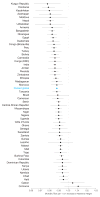Association of maternal stature with offspring mortality, underweight, and stunting in low- to middle-income countries
- PMID: 20407060
- PMCID: PMC3100588
- DOI: 10.1001/jama.2010.450
Association of maternal stature with offspring mortality, underweight, and stunting in low- to middle-income countries
Abstract
Context: Although maternal stature has been associated with offspring mortality and health, the extent to which this association is universal across developing countries is unclear.
Objective: To examine the association between maternal stature and offspring mortality, underweight, stunting, and wasting in infancy and early childhood in 54 low- to middle-income countries.
Design, setting, and participants: Analysis of 109 Demographic and Health Surveys in 54 countries conducted between 1991 and 2008. Study population consisted of a nationally representative cross-sectional sample of children aged 0 to 59 months born to mothers aged 15 to 49 years. Sample sizes were 2,661,519 (mortality), 587,096 (underweight), 558,347 (stunting), and 568,609 (wasting) children.
Main outcome measures: Likelihood of mortality, underweight, stunting, or wasting in children younger than 5 years.
Results: The mean response rate across surveys in the mortality data set was 92.8%. In adjusted models, a 1-cm increase in maternal height was associated with a decreased risk of child mortality (absolute risk difference [ARD], 0.0014; relative risk [RR], 0.988; 95% confidence interval [CI], 0.987-0.988), underweight (ARD, 0.0068; RR, 0.968; 95% CI, 0.968-0.969), stunting (ARD, 0.0126; RR, 0.968; 95% CI, 0.967-0.968), and wasting (ARD, 0.0005; RR, 0.994; 95% CI, 0.993-0.995). Absolute risk of dying among children born to the tallest mothers (> or = 160 cm) was 0.073 (95% CI, 0.072-0.074) and to those born to the shortest mothers (< 145 cm) was 0.128 (95% CI, 0.126-0.130). Country-specific decrease in the risk for child mortality associated with a 1-cm increase in maternal height varied between 0.978 and 1.011, with the decreased risk being statistically significant in 46 of 54 countries (85%) (alpha = .05).
Conclusion: Among 54 low- to middle-income countries, maternal stature was inversely associated with offspring mortality, underweight, and stunting in infancy and childhood.
Figures


Comment in
-
Maternal height and risk of child mortality and undernutrition.JAMA. 2010 Apr 21;303(15):1539-40. doi: 10.1001/jama.2010.469. JAMA. 2010. PMID: 20407066 No abstract available.
-
Association between maternal height and childhood outcomes.JAMA. 2010 Aug 11;304(6):638; author reply 638-9. doi: 10.1001/jama.2010.1107. JAMA. 2010. PMID: 20699453 No abstract available.
References
-
- Kramer MS. The epidemiology of adverse pregnancy outcomes: an overview. J Nutr. 2003;133(5 suppl 2):1592S–1596S. - PubMed
-
- Black RE, Allen LH, Bhutta ZA, et al. Maternal and Child Undernutrition Study Group. Maternal and child undernutrition: global and regional exposures and health consequences. Lancet. 2008;371(9608):243–260. - PubMed
-
- Silventoinen K. Determinants of variation in adult body height. J Biosoc Sci. 2003;35(2):263–285. - PubMed
-
- Martorell R, Habicht JP. Growth in early childhood in developing countries. In: Falkner F, Tanner JM, editors. Human Growth: A Comprehensive Treatise. 3. New York, NY: Plenum Press; 1986.

